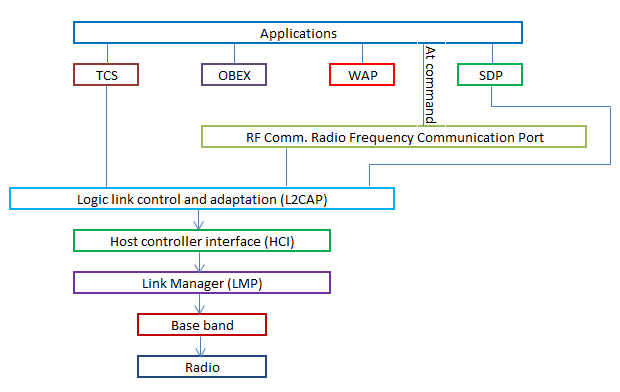Bluetooth
Bluetooth is a new technology that comes as an alternative to cables for connecting portable and fixed electronic devices and uses short range (10 meter) frequency hopping radio links for communication. It operates within the unlicensed ISM (Industrial scientific and medical) band at 2.4 GHz.
Bluetooth Features
Robustness - It uses a fast acknowledgement and frequency hopping scheme to make a radio link robust.
* Low complexity- The necessary transceiver components present in the devices are simple.
* Low cost- A wireless device with this technology is available at an affordable price.
Applications of Bluetooth
There are a variety of applications of Bluetooth such as
* Allows a transfer of images (or) word documents (or) applications (or) audio and video files between devices without the help of cables.
* Can be used for remote sales technology allowing wireless access to vending machines and other commercial enterprises.
* Provides inter accessibility of PDAs, palmtops and desktops for file and data exchanges.
* It can be used to setup a personal area network (PAN) or a wireless personal area network (WPAN).
Bluetooth Standards Documents
The documentation on Bluetooth can be split into TWO sections:
* Bluetooth specification and
* Bluetooth profiles
The specification section deals with the protocol architecture required for implementing bluetooth, while the profiles section describes in what ways we can utilize the Bluetooth technology.
Bluetooth Architecture
The protocol architecture of Bluetooth is given below:

The radio layer is responsible for:
* Modulation/Demodulation of data for transmitting (OR) receiving over air.
The base band layer is responsible for:
* Controlling the physical links via radio
* Assembling the packets
* Controlling frequency hopping.
The link manager protocol controls and configures links to other devices.
The host controller interface(HCI) handles communication between the host and the module. For this purpose, it uses several HCI command packets such as the even packets and data packets. The L2CAP layer converts the data obtained from higher layers into packets of different sizes.
The RF COMM provides a serial interface with wireless application protocol (WAP) and object exchange(OBEX).
WAP and OBEX provide interface to other communications protocols.
The TCS(Telephone control protocol specification) provide telephony service.
The SDP(Service discovery protocol) allows the devices to discover the services available on another Bluetooth enabled device.
The applications present in the application layer can extract the services of the lower layers by using one of the many profiles available.
Average Acceleration Calculator
Average acceleration is the object's change in speed for a specific given time period. ...
When an object falls into the ground due to planet's own gravitational force is known a...
In Mathematics, the permutation can be explained as the arrangement of objects in a particular order. It is an ordered...
A rectangle can be explained as a 4-sided quadrilateral which contains equal opposite sides. In a rectangle
A three sided polygon which has three vertices and three angles is called a triangle. Equilateral triangle...






